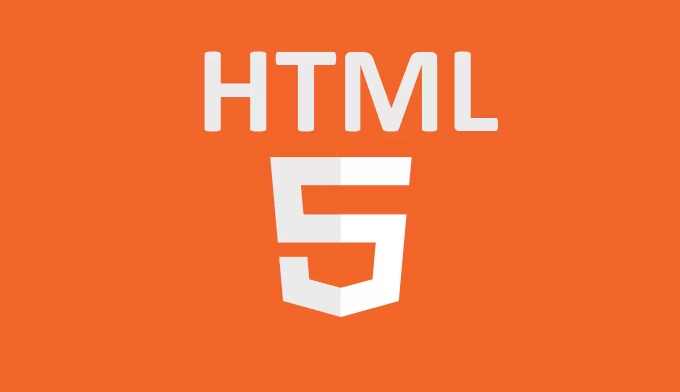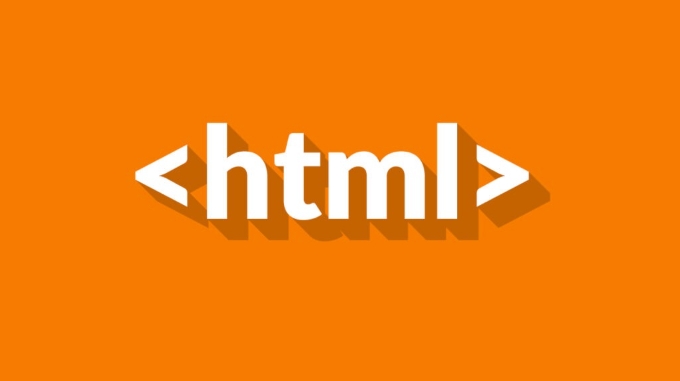Compared with HTML4, HTML5 has eight major improvements: 1. Added semantic tags such as

HTML5 is a significant evolution from HTML4, bringing improvements in structure, functionality, and compatibility with modern web development needs. Here are the key differences:

1. New Semantic Elements
HTML5 introduces semantic tags that clearly describe their meaning to both the browser and the developer. These make the structure of a webpage more meaningful and accessible.
Examples:

-
<header></header>– defines a header section -
<footer></footer>– defines a footer section -
<nav></nav>– defines navigation links -
<article></article>– defines independent content (eg, blog post) -
<section></section>– defines a section in a document -
<aside></aside>– defines content aside from the main content
In contrast, HTML4 relied heavily on generic <div> tags with class or ID attributes to define layout, which was less descriptive.<h3> 2. <strong>Native Support for Audio and Video</strong>
</h3>
<p> HTML5 includes built-in support for multimedia without requiring third-party plugins like Flash. </p>
<img src="/static/imghw/default1.png" data-src="https://img.php.cn/upload/article/000/000/000/175410162785235.jpeg" class="lazy" alt="How is HTML5 different from HTML4?"><ul>
<li> <code><audio></audio> – embeds sound content
<video></video> – embeds video content In HTML4, embedded media required using <object></object> or <embed></embed> with external plugins, which was less reliable and not mobile-friendly.
3. Graphics and Drawing Capabilities
HTML5 introduced:
-
<canvas></canvas>– allows dynamic, scriptable rendering of 2D shapes and bitmap images - SVG support – inline scalable vector graphics
HTML4 had no native support for drawing or graphics on the webpage.
4. Improved Form Controls and Input Types
HTML5 adds new input types for better user input handling and validation:
-
email,url,number,range,date,color,search, etc.
It also supports new attributes like:
-
placeholder,required,autofocus,autocomplete
These reduce the need for JavaScript validation and improve user experience on mobile and desktop.
5. APIs for Enhanced Functionality
HTML5 comes with a suite of JavaScript APIs that enable richer web applications:
- Local storage (
localStorageandsessionStorage) - Geolocation API
- Drag and drop
- Web Workers (background processing)
- Web Sockets (real-time communication)
HTML4 had limited or no support for these features, requiring external plugins or complex workarounds.
6. Simplified Doctype and Charset Declaration
HTML5 uses a much simpler and easier-to-remember syntax:
<!DOCTYPE html> <meta charset="UTF-8">
Compare this to HTML4:
<!DOCTYPE HTML PUBLIC "-//W3C//DTD HTML 4.01//EN" "http://www.w3.org/TR/html4/strict.dtd"> <meta http-equiv="Content-Type" content="text/html; charset=utf-8">
The HTML5 version is cleaner and less error-prone.
7. Better Error Handling and Browser Compatibility
HTML5 is designed to be more forgiving and consistent across browsers. Even if a browser doesn't support a certain feature, it usually degrades gracefully. HTML4 was stricter and less flexible in how browsers interpreted malformed code.
8. Mobile and Device Support
HTML5 was developed with mobile devices in mind. Features like responsive design support, touch events, and offline capabilities make it ideal for mobile web apps—something HTML4 wasn't built for.
In short, HTML5 isn't just an update—it's a complete overhaul that supports modern web applications, improves accessibility, and reduces reliability on external plugins. It's more semantic, functional, and future-ready than HTML4.
The above is the detailed content of How is HTML5 different from HTML4?. For more information, please follow other related articles on the PHP Chinese website!

Hot AI Tools

Undress AI Tool
Undress images for free

Undresser.AI Undress
AI-powered app for creating realistic nude photos

AI Clothes Remover
Online AI tool for removing clothes from photos.

Clothoff.io
AI clothes remover

Video Face Swap
Swap faces in any video effortlessly with our completely free AI face swap tool!

Hot Article

Hot Tools

Notepad++7.3.1
Easy-to-use and free code editor

SublimeText3 Chinese version
Chinese version, very easy to use

Zend Studio 13.0.1
Powerful PHP integrated development environment

Dreamweaver CS6
Visual web development tools

SublimeText3 Mac version
God-level code editing software (SublimeText3)
 Adding drag and drop functionality using the HTML5 Drag and Drop API.
Jul 05, 2025 am 02:43 AM
Adding drag and drop functionality using the HTML5 Drag and Drop API.
Jul 05, 2025 am 02:43 AM
The way to add drag and drop functionality to a web page is to use HTML5's DragandDrop API, which is natively supported without additional libraries. The specific steps are as follows: 1. Set the element draggable="true" to enable drag; 2. Listen to dragstart, dragover, drop and dragend events; 3. Set data in dragstart, block default behavior in dragover, and handle logic in drop. In addition, element movement can be achieved through appendChild and file upload can be achieved through e.dataTransfer.files. Note: preventDefault must be called
 Getting user location with HTML5 geolocation API
Jul 04, 2025 am 02:03 AM
Getting user location with HTML5 geolocation API
Jul 04, 2025 am 02:03 AM
To call GeolocationAPI, you need to use the navigator.geolocation.getCurrentPosition() method, and pay attention to permissions, environment and configuration. First check whether the browser supports API, and then call getCurrentPosition to obtain location information; the user needs to authorize access to the location; the deployment environment should be HTTPS; the accuracy or timeout can be improved through configuration items; the mobile behavior may be limited by device settings; the error type can be identified through error.code and given corresponding prompts in the failed callback to improve user experience and functional stability.
 Using ARIA attributes with HTML5 semantic elements for accessibility
Jul 07, 2025 am 02:54 AM
Using ARIA attributes with HTML5 semantic elements for accessibility
Jul 07, 2025 am 02:54 AM
The reason why ARIA and HTML5 semantic tags are needed is that although HTML5 semantic elements have accessibility meanings, ARIA can supplement semantics and enhance auxiliary technology recognition capabilities. For example, when legacy browsers lack support, components without native tags (such as modal boxes), and state updates need to be dynamically updated, ARIA provides finer granular control. HTML5 elements such as nav, main, aside correspond to ARIArole by default, and do not need to be added manually unless the default behavior needs to be overridden. The situations where ARIA should be added include: 1. Supplement the missing status information, such as using aria-expanded to represent the button expansion/collapse status; 2. Add semantic roles to non-semantic tags, such as using div role to implement tabs and match them
 Securing HTML5 web applications against common vulnerabilities
Jul 05, 2025 am 02:48 AM
Securing HTML5 web applications against common vulnerabilities
Jul 05, 2025 am 02:48 AM
The security risks of HTML5 applications need to be paid attention to in front-end development, mainly including XSS attacks, interface security and third-party library risks. 1. Prevent XSS: Escape user input, use textContent, CSP header, input verification, avoid eval() and direct execution of JSON; 2. Protect interface: Use CSRFToken, SameSiteCookie policies, request frequency limits, and sensitive information to encrypt transmission; 3. Secure use of third-party libraries: periodic audit dependencies, use stable versions, reduce external resources, enable SRI verification, ensure that security lines have been built from the early stage of development.
 Integrating CSS and JavaScript effectively with HTML5 structure.
Jul 12, 2025 am 03:01 AM
Integrating CSS and JavaScript effectively with HTML5 structure.
Jul 12, 2025 am 03:01 AM
HTML5, CSS and JavaScript should be efficiently combined with semantic tags, reasonable loading order and decoupling design. 1. Use HTML5 semantic tags, such as improving structural clarity and maintainability, which is conducive to SEO and barrier-free access; 2. CSS should be placed in, use external files and split by module to avoid inline styles and delayed loading problems; 3. JavaScript is recommended to be introduced in front, and use defer or async to load asynchronously to avoid blocking rendering; 4. Reduce strong dependence between the three, drive behavior through data-* attributes and class name control status, and improve collaboration efficiency through unified naming specifications. These methods can effectively optimize page performance and collaborate with teams.
 Using HTML5 Semantic Elements for Page Structure
Jul 07, 2025 am 02:53 AM
Using HTML5 Semantic Elements for Page Structure
Jul 07, 2025 am 02:53 AM
Using HTML5 semantic tags can improve web structure clarity, accessibility and SEO effects. 1. Semantic tags such as,,,, and make it easier for the machine to understand the page content; 2. Each tag has a clear purpose: used in the top area, wrap navigation links, include core content, display independent articles, group relevant content, place sidebars, and display bottom information; 3. Avoid abuse when using it, ensure that only one per page, avoid excessive nesting, reasonable use and in blocks. Mastering these key points can make the web page structure more standardized and practical.
 HTML5 video not playing in Chrome
Jul 10, 2025 am 11:20 AM
HTML5 video not playing in Chrome
Jul 10, 2025 am 11:20 AM
Common reasons why HTML5 videos don't play in Chrome include format compatibility, autoplay policy, path or MIME type errors, and browser extension interference. 1. Videos should be given priority to using MP4 (H.264) format, or provide multiple tags to adapt to different browsers; 2. Automatic playback requires adding muted attributes or triggering .play() with JavaScript after user interaction; 3. Check whether the file path is correct and ensure that the server is configured with the correct MIME type. Local testing is recommended to use a development server; 4. Ad blocking plug-in or privacy mode may prevent loading, so you can try to disable the plug-in, replace the traceless window or update the browser version to solve the problem.
 Embedding video content using the HTML5 `` tag.
Jul 07, 2025 am 02:47 AM
Embedding video content using the HTML5 `` tag.
Jul 07, 2025 am 02:47 AM
Embed web videos using HTML5 tags, supports multi-format compatibility, custom controls and responsive design. 1. Basic usage: add tags and set src and controls attributes to realize playback functions; 2. Support multi-formats: introduce different formats such as MP4, WebM, Ogg, etc. through tags to improve browser compatibility; 3. Custom appearance and behavior: hide default controls and implement style adjustment and interactive logic through CSS and JavaScript; 4. Pay attention to details: Set muted and autoplay to achieve automatic playback, use preload to control loading strategies, combine width and max-width to achieve responsive layout, and use add subtitles to enhance accessibility.






